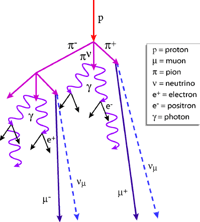Topic 1:
The Cosmic Ray Puzzle
 |
| When CRs strike air molecules, they create a shower of different subatomic particles. |
| enlarge |
Cosmic rays (CRs) are not actually beams or rays, but individual fast-moving charged particles. Over 90 percent are protons and helium nuclei, although they include nuclei of nearly all the elements. About 1 percent are electrons.
CRs were first detected in 1912 by physicist Victor Hess, using instruments in a balloon that ascended to 5300 meters. For a time, many thought that the "rays" emanated from Earth. Progressively more sophisticated observations revealed that the particles are extraterrestrial in origin and span a remarkable range of energies—at least 12 orders of magnitude. That is, the energy content of particles varies by a factor of as much as one trillion, and maybe more. No one knows how high the energies can go.
The least energetic particles are the most frequent, and scientists have identified processes that could accelerate particles to most of the observed energies, which are typically expressed in units of electron volts. (One eV is the energy an electron gains when it is accelerated through an electrical potential of one volt.) Where things really start to get interesting is at energies around 100 to 1000 trillion (1014-1015) eV and above. Particles in that range must have been propelled by some truly violent astrophysical process in our galaxy or beyond.
 |
| Dr. Seo and a student in the CREAM data center at UMD. |
| enlarge |
"This galactic component of the cosmic-ray spectrum must be produced by some engine that is powerful enough to account for the energy we see. The bulk of such galactic cosmic rays are thought to be accelerated by something like a supernova," Seo says, referring to the stupendous explosion that occurs when an extremely massive star reaches the end of its lifetime.
"However, supernovae are supposed to have limits to their acceleration capability, around 1015 electron volts or so. And yet we have detected particles with energies far above that in ground-based experiments." Indeed, surface detectors have recorded CRs with energies of 1021 eV—a million times higher than the presumed supernova cut-off. "We still don't know what the acceleration limit is," says Seo. "That is what we are trying to explore with CREAM," an international collaboration studying high-energy CRs. UMD has a major data and operations center for CREAM on campus. (See Topic 3: ATIC and CREAM.)
 |
| The spectrum of observed cosmic ray energies. The vertical axis is frequency of occurrence; the horizontal axis is energy. The arrow shows the 'knee.' |
| enlarge |
The CREAM team is focusing on a key subset of CRs—those at the "knee" of the distribution curve. Below energies of about 1015 eV, CRs are hugely abundant: Those with energies of 1011 eV pass through every square meter of our regions of space at the rate of about one per second. But at the 1015 eV point—the assumed limit of supernova acceleration—the rate drops to one a year and continues to fall off dramatically thereafter. At 1018 eV, it's one particle per year for every square kilometer. Obviously, something significant is happening in that energy range that could shed considerable light on the mechanisms that accelerate, propagate and confine particles. Seo and colleagues are at the forefront of that effort. Back to Top
|

